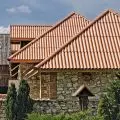The Hangar Ticinum competition organized by TerraViva Competitions resulted in numerous successes for teams from Poland. The first prize went to The house of light project by Paulina Górecka and Paulina Pawlikowska, graduates of the Faculties of Architecture at the Wrocław University of Technology and the Warsaw University of Technology. The goal of the winning architects was to bring life back into the former hydroplane hangar by transforming it into a cultural platform and theater, all while respecting the history of the site.
The goal of the Hangar Ticinum competition was to restore the splendor of a former hangar located on the Ticinum River in Pavia, a small Italian town known for its university, local food and wine, and rich cultural offerings. However, Pavia is not only a remarkable artistic heritage, at the beginning of the 20th century, like many other Italian towns in the north, the town was booming with industry.
Idroscalo hangar in Pavia, photo from 1933
© Musei Civici
Numerous ruins of buildings remain from Pavia's industrial period, spreading along the Ticinum River. The most distinctive building is located just inside the gate of the historic center - the Idroscalo hangar, designed in the 1920s by a young Italian architect - Giuseppe Pagano.
You can read about the details of the competition and the history of the Idroscalo hangar in the article on the awarded project THE LIFE FRAMES by Kamila Boroch, Katarzyna Jasinska, Aleksandra Piechota and Marcelina Terelak, students of Wroclaw University of Technology.
Idroscalo hangar is located just outside the historic center of Pavia
© Paulina Górecka, Paulina Pawlikowska
first prize for PW and PWr graduates
The projects submitted to the Hangar Ticinium competition were evaluated by an international jury consisting of: German Fuenmayor (PIUARCH), Anastasia Kucherova (Stefano Boeri Architetti), Lorenzo Degli Esposti (DEGLI ESPOSTI ARCHITETTI) Mariangela Singali Calisti (Pavia City Hall), Filippo Imberti (TSPA), Luca Paci (OPERASTUDIO), Bogdan Peric (Untitled Architecture) Toufic Rifai (Politecnico di Milano).
The jury decided to award three main prizes. First Prize for The house of light project was won by young architects from Poland - Paulina Górecka and Paulina Pawlikowska.
Second Prize went to Devin Dobrowolski from the United States, and Third Prize went to a team consisting of: Valeria Paez Cala and Luisa Brando. Four honorable mentions (Golden Mentions) and ten honorable mentions were also awarded, among which was a project from Poland - THE LIFE FRAMES by a team of students from the Wroclaw University of Technology.
The authors filled the walls of the hangar with glass blocks
© Paulina Górecka, Paulina Pawlikowska
a house full of light
The Idroscalo building is strategically located on the riverbank, thus acting as a gateway to Pavia. The hangar is an iconic architectural landmark that has become a strong part of the city's skyline. Historically, the building was a stop for hydroplanes landing on the river, providing a transfer of people from the river to the city. The authors' goal, therefore, was to bring life back into the abandoned building, but with respect for the history it represents.
The hangar stands on a strong concrete platform above the river. The building's structure is solid, but the infill of the brick walls has deteriorated. Our project involved removing the deteriorated bricks from the wall structure and replacing them with glass blocks. This procedure made it possible to let light into the building during the day and let it out at night. As a result, Idroscalo is once again becoming a landmark on the city map, attracting visitors with its interesting form, and at night, like a beacon, inviting people from all sides," the architects explained.
A characteristic element of the building is the staircase
© Paulina Górecka, Paulina Pawlikowska
cultural platform
The authors assume that after reconstruction, the hangar will become a new cultural, social and viewing platform for the city, attracting a wider audience. The rails for towing hydroplanes were converted into stairs leading to the river.
The stair structure has been pulled into the building, creating a new hierarchy of space - enabling a variety of activities. The stairs become the theater's auditorium, and allow access to the terrace, which is an excellent vantage point for viewing the river and the water sports practiced on it.
The construction of the trusses and curtains makes it possible to organize performances against the backdrop of the river
© Paulina Górecka, Paulina Pawlikowska
shakespearean theater inspiration
The architects alluded to the typology of Shakespearean theater with the form of the designed building. Stairs at the façade and terraces surround the central space, which is a platform with mobile elements. The mobile elements make it possible to obtain different stage-viewing room configurations, as well as to create a workshop space. Performances could take place against the backdrop of an open outdoor space overlooking the river.
The original design of the trusses and curtains makes it possible to organize theatrical performances against the backdrop of the river, installing lights and decorations. Visitors to the building create a shadow play on the façade, making them themselves participants in the performance and part of The house of light, the authors conclude.










































